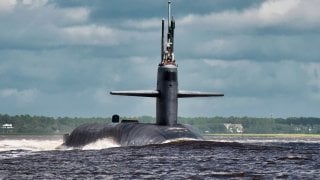America Has an Ohio-Class 'Cruise Missile Submarine' on 'Iran's Doorstep'
The USS Georgia, a U.S. Navy guided-missile submarine of the Ohio-Class, has been positioned closer to Iran amidst heightened tensions in the Middle East following a brutal Hamas attack on Israel.
Summary and Key Points You Need to Know: The USS Georgia, a U.S. Navy guided-missile submarine of the Ohio-Class, has been positioned closer to Iran amidst heightened tensions in the Middle East following a brutal Hamas attack on Israel.
-The deployment could be a signal to Iran, a key supporter of Hamas and Hezbollah, that any escalation against U.S. regional partners would be met with force.
-This move also comes amid growing military cooperation between Iran and Russia, which raises concerns over Iran's strengthening air and anti-ship defenses.
-The presence of the USS Georgia ensures the U.S. can retaliate if Iran or its proxies provoke further aggression in the region.
Why is a US Navy Guided-Missile Submarine Getting Closer to Iran?
Tensions in the Middle East are soaring. Hamas launched a brutal attack from the Gaza Strip against Israel last October, throwing the region into its greatest geopolitical crisis in decades. Israel, reeling from the embarrassment and shock of the brazen Hamas attack, has striven to restore its obviously broken deterrence.
Iran supports Hamas and is the ultimate culprit behind the attack. Tehran has spent the last year expanding its capabilities, shoring up critical alliances, and further pressuring the already squeezed Israeli military.
The Context
In recent weeks, the U.S. Navy has deployed an inordinate amount of assets to the waters surrounding the Greater Middle East. A recent deployment, however, has raised eyebrows in Tehran. USS Georgia transited from the Mediterranean Sea via the Suez Canal. This comes after Georgia was off the coast of the Levant due to the ongoing crisis between in Lebanon between Israel, Hamas, and Hezbollah.
It could be that Georgia is meandering out of the region with plans to leave altogether. But it should be noted that the Israelis have been increasing their operational tempo against Hezbollah targets in Lebanon. Given that Washington has decided to enhance regional deterrence by deploying the bulk of the Navy to the region, it could be that Georgia is moving its arsenal of Tomahawk cruise missiles closer to Iran.
After all, the Islamic Republic of Iran is Hezbollah’s biggest state sponsor. In fact, Hezbollah is essentially an arm of the Islamic Revolutionary Guard Corps. And for months, Israel has been targeting Hezbollah and IRGC leaders across the region in increasingly brazen assassinations.
This has been done to keep Israel’s gathering enemies off balance. Of course, it has only further destabilized the geopolitical situation in the near term.
Considering that Hezbollah is a proxy of the Islamic Republic, and that Iran has been threatening massive retaliation for weeks, repositioning Georgia closer to Iranian shores could be Washington’s attempt to signal that escalation by Iran against America’s regional partners is a very bad idea.
Then again, Iran has been operating as though the Americans are not really a significant factor. Yes, Georgia and other assets deployed to the region could wreak havoc upon Iran. Or, at least, they could have. That’s an important qualifier because since the start of the crisis with Israel, the Russian Federation has been intensifying its strategic partnership with Tehran.
The Russia Connection
A military supply chain between Moscow and Tehran. Iran sends Russia drones and cheap rockets, while Russia supplies Iran with anti-aircraft and anti-ship defense systems, among other systems.
This elicits a variety of concerns, such as the degree to which Russia is helping Iran build out an advanced, robust layered air defense and anti-ship ballistic weapons capability. Georgia’s presence, then, becomes even more important, since a robust anti-ship missile capability would challenge the U.S. Navy’s surface fleet.

The Implications
The threat of a wider regional war has only worsened, and guided-missile submarines like USS Georgia are more important than they’ve ever been.
By having a nuclear-powered guided-missile submarine within striking distance of Iran or Houthi ground targets, the U.S. military is ensuring that it can reliably retaliate if Iran agitates for greater aggression against Israel or the United States.
Even then, the amount of systems the Russians might have offloaded to the Iranians could mean that all those lethal Tomahawk cruise missiles that the Georgia and submarines like it can spew at Iran might be shot down by Russian-built air defense systems in Iran.
Should these trends persist, Iran might be able to build a proficient air defense and anti-ship defense network ringing their country and protecting its proxies, notably the Houthis. This could shift the balance of power in the Greater Middle East toward Iran and its proxies, as well as Russia and China.
Once adequately defended, the Iranians will believe they can attack their enemies with impunity.
Author Experience and Expertise: Brandon J. Weichert
Brandon J. Weichert, a National Interest national security analyst, is a former Congressional staffer and geopolitical analyst who is a contributor at The Washington Times, the Asia Times, and The-Pipeline. He is the author of Winning Space: How America Remains a Superpower, Biohacked: China’s Race to Control Life, and The Shadow War: Iran’s Quest for Supremacy. His next book, A Disaster of Our Own Making: How the West Lost Ukraine, is due October 22 from Encounter Books. Weichert can be followed via Twitter @WeTheBrandon.
All images are Creative Commons or Shutterstock.
From the Vault
Russia Freaked Out: Why the U.S. Navy 'Unretired' the Iowa-Class Battleships
Battleship vs. Battlecruiser: Iowa-Class vs. Russia's Kirov-Class (Who Wins?)


